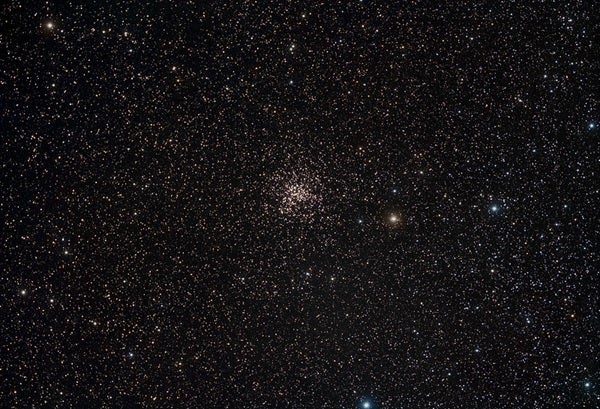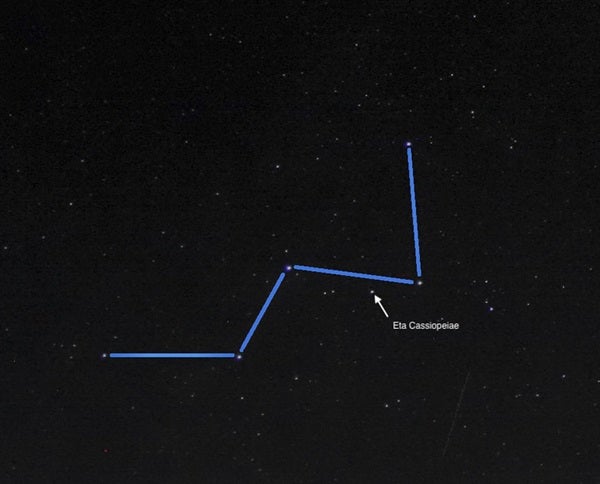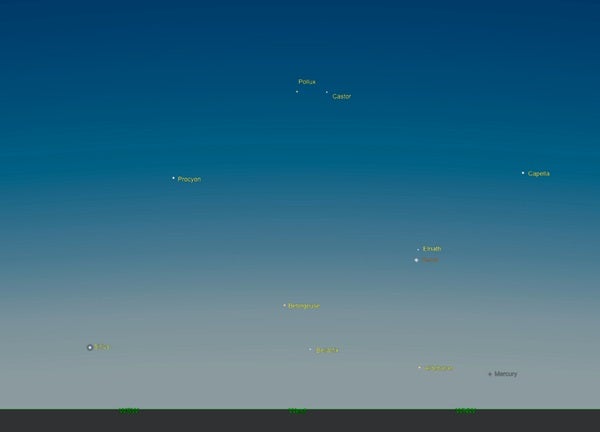The bright Moon rises just before 10 P.M. local time, so you’ll want to observe fainter objects earlier in the evening. Auriga is a wreath-shaped constellation whose brightest star, Capella, is an easy-to-spot magnitude 0.1. Look northwest after sunset to find it, then skim 10.5° due southeast of the star with binoculars or a small scope to find M38 (NGC 1912), an open star cluster sometimes referred to as the Starfish Cluster. Less than 2.5° east-southeast of the Starfish is open cluster M36 (NGC 1960), also known as the Pinwheel Cluster. Finally, hop 3.7° east-southeast of M36 to find M37 (NGC 2099), the richest of Auriga’s three open clusters.

Astronomy is pleased to present The Complete Star Atlas, the perfect resource for stargazers of all ages. This practical guide to viewing the night sky includes approximately 87,000 stars, 1,200 deep-sky objects, and 24 high-quality star maps. You’ll also find 50 pages of astronomy history, tips, and more from experienced Contributing Editor Michael E. Bakich.
Mars crosses from Capricornus into Aquarius today. Look for the Red Planet just 3.7° from Delta [δ] Capricorni before sunrise this morning. With a bright Moon relatively nearby, finding fainter objects will be difficult.
Instead, try seeking out larger shapes among the stars. The Square of Pegasus lies northeast of Capricornus, anchored by Alpheratz, Algenib, Scheat, and Markab, all between magnitudes 2 and 3. Then look northwest to spot the three bright stars of the Summer Triangle: Deneb, Vega, and Altair. And above the northern horizon, you’ll find the Big and Little Dippers, both circling around the dim North Star, Polaris.
Today is Mother’s Day; in celebration of one celestial mother, look north after sunset to see Cassiopeia the Queen just above the horizon. As a circumpolar constellation, she swings lower as midnight approaches, then begins to arc upward in the early hours of May 11.
The vain Cassiopeia may not be the best mythological mother for dooming her daughter Andromeda to death — don’t worry, the princess was rescued — but the Queen does harbor some excellent observing gems. With the Moon still below the horizon this evening, try to hunt down the brilliant double star Achird (Eta [η] Cassiopeiae), located roughly halfway between Navi and Shedar (Gamma [γ] and Alpha [α] Cassiopeiae, respectively). Achird appears as a bright, golden magnitude 3.5 star with a fainter, 7th-magnitude companion that may appear red, orange, or even reddish-purple, depending on the viewer. You’ll need a mere 50x magnification to split the pair, currently about 13″ apart.
If you’re looking for a more challenging system, instead turn to Iota [ι] Cassiopeiae, 12° northeast of Navi. Iota is a tight triple star system whose components have magnitudes of 4.6, 6.9, and 8.4. Scopes smaller than 3 inches will need to push the magnification to 100x or greater (under good seeing conditions) to split these stars. Viewing this trio with a small scope may be difficult if the air near the horizon is turbulent.
Monday, May 11
Visible within an hour of midnight and marching upward in the sky as the night progresses, Saturn and its moons make a great target tonight. The two-faced moon Iapetus shines around magnitude 11 at inferior conjunction; you’ll find it 48″ due south of Saturn, with several other moons — Mimas, Tethys, Dione, Enceladus, and Rhea — spread out to the planet’s west. Farther to the northwest, Titan shines a little less than 2.5′ from Saturn’s center.
Saturn is stationary at 5 A.M. EDT; after today, it will make a sharp turn and begin moving west against the background stars. Two hours later, asteroid Pallas is stationary at 7 A.M. EDT. Unlike the giant planet’s quick reversal of course, the asteroid will make a much wider, gentler turn in the sky, slowly shifting its motion westward over the next several weeks.
Tuesday, May 12
The waning Moon passes 2° south of Jupiter at 6 A.M. EDT. If you step out an hour before sunrise, you can catch the trio in the southern sky. Our Moon is 71 percent lit, with Jupiter glowing brightly above it. To Jupiter’s left (east) is Saturn, less than 5° away. Scan farther east to spot Mars at roughly the same altitude. The Red Planet sits about 20° above magnitude 1.2 Fomalhaut, which is low on the southeastern horizon.
To the right (west) of the Moon-Jupiter pair, you’ll find the familiar Teapot asterism of Sagittarius, with its spout tilted slightly toward the horizon. If you’ve got a clear view all the way to the horizon, follow the spout to find the long, curving tail of Scorpius. The Scorpion’s glowing red heart, magnitude 1 Antares, is at roughly the same altitude as the tip of the Teapot’s spout, magnitude 3 Alnasl (Gamma Sagittarii).
Later today, the Moon passes 3° south of Saturn at 2 P.M. EDT.
Venus is stationary at 6 A.M. EDT this morning, but you’ll have to wait until evening to spot the crescent world. Half an hour after sunset, Venus and Mercury are sinking toward the west-northwest horizon. From mid-northern latitudes, magnitude –1.3 Mercury stands only 4° high, while magnitude –4.4 Venus is 20° high. Venus is now just 13 percent lit, but with an apparent diameter of 48″. As darkness falls, you’ll first spot bright Sirius — also low on the horizon to the southwest of the planetary pair — and then other bright stars, such as Aldebaran, Betelgeuse, Castor, and Pollux. Venus is less than 1.5° southwest of magnitude 1.7 Elnath (Beta [β] Tauri). To its north is Capella, Auriga’s brightest member.
Today marks the end of Venus’ northeasterly track against the background stars; it will now turn and begin marching back toward the southwest.
Thursday, May 14
Jupiter’s moons put on a particularly good show this morning. As midnight changes the date from the 13th to the 14th on the East Coast, Ganymede is already one-quarter of its way through a transit across the planet’s disk, trailed by its shadow to the southeast. An hour later, Ganymede is halfway across the planet, its shadow directly beneath it. By 2 A.M. EDT, Ganymede is three-quarters across, and its shadow now precedes it to the southwest. At the same time, Europa is poised at Jupiter’s eastern limb, ready to begin its own transit, which progresses over the next 2 hours 45 minutes or so.
During that same timespan, Io, which started the night out to Jupiter’s southwest, disappears behind the planet. Eastern observers likely won’t see it reappear, thanks to sunrise, but observers in the Midwestern and Western U.S. can catch it emerging from behind Jupiter’s eastern limb just after 4:30 A.M. CDT.
A 52-percent-lit Moon is closing in on Mars this morning. By sunrise, our satellite is less than 9° southwest of the Red Planet in the southern sky. Using Mars as a starting point, look 29° west to spot magnitude 0.5 Saturn. From the ringed planet, it’s a short 4.7° jump southwest to Jupiter, shining at magnitude –2.5.
Last Quarter Moon occurs at 10:03 A.M. EDT. A few hours later, Jupiter is stationary at 2 P.M. EDT. Observers who’ve been following the giant planet have seen it trekking eastward through Sagittarius. Now, the king of planets will turn sharply and head back to the west.
The Moon passes 3° south of Mars at 10 P.M. EDT, although the two are still below the horizon when this occurs.
Friday, May 15
After passing perihelion (its closest point to the Sun) last week on May 4, Comet PanSTARRS (C/2017 T2) is at peak brightness this month, reaching magnitudes 8 to 9. The best time to spot the comet today is in the morning between midnight and moonrise (shortly after 2:30 A.M. local time), or again after the sky darkens following sunset tonight. Currently in the constellation Camelopardalis, PanSTARRS is always above the horizon for most U.S. observers, so it’s just a matter of finding a time when the sky is dark enough to see it with your scope.
PanSTARRS is relatively easy to find using the bowl of the Big Dipper. Swing your telescope from Dubhe, the bright star that forms the upper right corner of the bowl, about 17° northwest to spot this inner solar system visitor. If you have trouble finding it or experience poor weather, don’t despair. In one week, New Moon will occur as the comet skims by a famous pair of galaxies (M81 and M82) in Ursa Major, making it both easier to find and creating an enjoyable tableau.

Our exclusive Sky Guide 2020 is now available! This free downloadable pamphlet contains a month-by-month rundown of 2020’s biggest celestial events, from Mars’ best opposition in years to the return of totality in South America this December. Check out Astronomy’s Sky Guide 2020 now!












